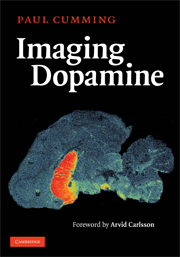Book contents
- Frontmatter
- Contents
- Foreword
- Acknowledgments
- Introduction
- 1 The life history of dopamine
- 2 Enzymology of tyrosine hydroxylase
- 3 The assay of tyrosine hydroxylase
- 4 Enzymology of aromatic amino acid decarboxylase
- 5 PET studies of DOPA utilization
- 6 Conjugation and sulfonation of dopamine and its metabolites
- 7 Dopamine synthesis and metabolism rates
- 8 MAO activity in the brain
- 9 Vesicular storage of dopamine
- 10 Dopamine release: from vesicles to behavior
- 11 The plasma membrane dopamine transporter
- 12 Dopamine receptors
- 13 Imaging dopamine D1 receptors
- 14 Imaging dopamine D2 receptors
- 15 Factors influencing D2 binding in living brain
- 16 The absolute abundance of dopamine receptors in the brain
- 17 Conclusions and perspectives
- References
- Index
- Plate section
3 - The assay of tyrosine hydroxylase
Published online by Cambridge University Press: 04 December 2009
- Frontmatter
- Contents
- Foreword
- Acknowledgments
- Introduction
- 1 The life history of dopamine
- 2 Enzymology of tyrosine hydroxylase
- 3 The assay of tyrosine hydroxylase
- 4 Enzymology of aromatic amino acid decarboxylase
- 5 PET studies of DOPA utilization
- 6 Conjugation and sulfonation of dopamine and its metabolites
- 7 Dopamine synthesis and metabolism rates
- 8 MAO activity in the brain
- 9 Vesicular storage of dopamine
- 10 Dopamine release: from vesicles to behavior
- 11 The plasma membrane dopamine transporter
- 12 Dopamine receptors
- 13 Imaging dopamine D1 receptors
- 14 Imaging dopamine D2 receptors
- 15 Factors influencing D2 binding in living brain
- 16 The absolute abundance of dopamine receptors in the brain
- 17 Conclusions and perspectives
- References
- Index
- Plate section
Summary
Accumulation of DOPA after treatment with NSD 1015
General aspects
In the previous chapter, the kinetics of TH in vitro has been discussed in detail. It is clear that the net activity of TH under physiological conditions must be determined by the multiplicity of regulatory factors prevailing in the living brain. This chapter reviews and contrasts the several methods developed for the assay of TH in living brain. In vitro assays of TH activity are based on the formation of product in a reaction vessel under controlled conditions. However, there is no known mechanism for sequestering or concentration of DOPA in living brain. Basal concentrations of DOPA in brain are normally low because of its unimpeded diffusion back into circulation, and because of the high activity of AAADC relative to that of TH. The normally prodigious activity of cerebral AAADC in the brain of living rat is substantially blocked by treatment with the irreversible enzyme inhibitor m-hydroxybenzyl-hydrazine (NSD 1015), which forms a hydrazone derivative with the pyridoxal phosphate co-factor of AAADC. This blockade is essentially complete in rat brain when the drug is administered at a dose of at least 50 mg kg−1 (Watanabe 1985). In the absence of AAADC activity, DOPA formed from tyrosine then accumulates in the brain tissue (Carlsson et al. 1972). This accumulation appears to be linear with time, from which the rate of DOPA synthesis can be calculated by linear regression.
- Type
- Chapter
- Information
- Imaging Dopamine , pp. 29 - 44Publisher: Cambridge University PressPrint publication year: 2009



